A Beginner’s Guide to Bid Optimization in Apple Ads
 Gabriel Kuriata
Gabriel Kuriata Bidding is the most critical component of Apple Ads’ optimization and any beginner’s most significant consideration. It involves strategically adjusting bids to improve the performance of keywords and ads while staying within the budget.
An advertiser needs to carefully consider many factors like campaign goals, types, metrics, availability of historical data, and competition to adjust bids by the right amount at an optimal frequency. Success is not possible without a data-driven approach and a good working regimen.
Mastering bidding in Apple Ads means knowing the following:
Succeeding, on the other hand, requires:
This article will show how to approach bidding as a vital part of Apple Ads optimization. It includes rules and best practices that can provide you with an excellent framework for managing your advertising budget efficiently and effectively, reducing spend on experimentation and testing to an affordable minimum.
Apple Ads provides vital reference and data for advertisers to make informed decisions. Additionally, SplitMetrics offers a rich suite of features to make your bid optimization and management as effective and profitable as possible, with AI bid management, condition-based bid strategies, and smart automation rules.
Bid optimization immensely benefits from Apple Ads automation, as it involves simple, frequent, and highly repetitive actions, such as raising or lowering bids or pausing and unpausing keywords or ads. Setting up a simple automation rule creates a framework for data-driven, bias-free, swift, and flexible bidding. The complexity of large-scale campaigns incentivizes advertisers to explore AI bid optimization, which SplitMetrics offers.
In Apple Ads, advertisers bid to display their ads. The platform utilizes the cost per tap (CPT) model, which means participants pay only for taps, regardless of generated impressions.
Each time a user taps on your ad, you will pay an amount equal to what your closest competitor is willing to pay, plus an additional 1 cent USD, until your max CPT bid level is reached.
Max CPT bid is a parameter configured on an ad group, keyword, and individual ad level. It reflects the maximum amount you are ready to pay for a tap on your ad.
However, money spent isn’t the only factor determining the likelihood of an ad being shown! Ad relevance and user engagement are crucial. Prioritizing them is the safest strategy for building long-term visibility on the App Store. Look at the example below:
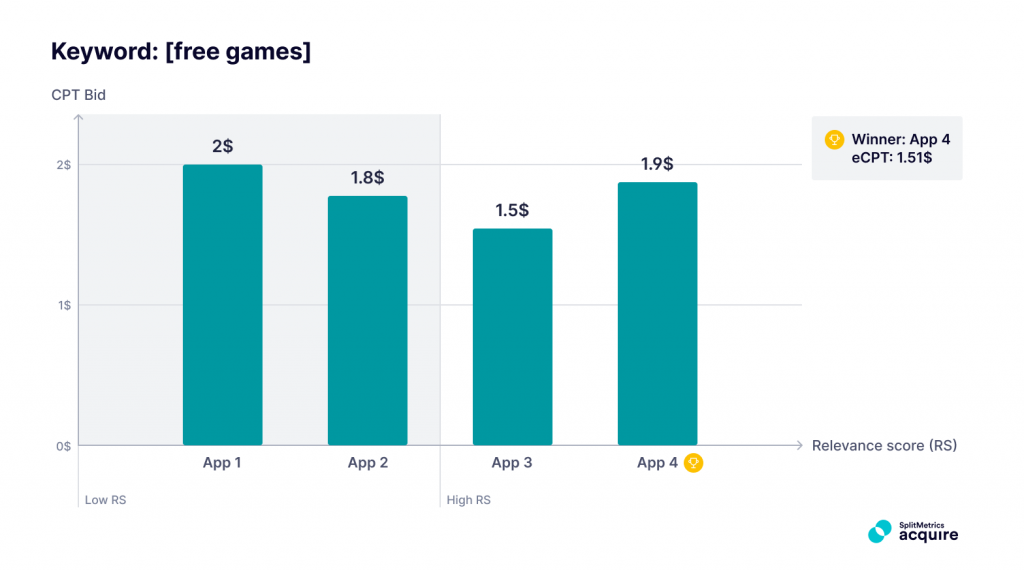
Even the most courageous bidding will not bring success if you don’t select the right keywords or target your ads to the right audience. You may generate taps, but they won’t lead to downloads and engagement. Low conversion rates will signal that your app is not worth showing to users, hurting your visibility.
In this context, it’s clear that app store optimization (ASO) is vital to successful campaigns with all Apple Ads placements, as its key focus is conversion rate optimization. There are more things to consider before you jump into bid optimization.
Apple Ads and ASO are strongly connected. A strategic approach to both can create a synergistic effect, visible through improved conversion rates and better visibility. One of the pillars of ASO is conversion rate optimization, a process with a tremendous impact on cost per tap (CPT). Having the best screenshots, an engaging app ivon will improve tap-through and conversion rates, significantly lowering your cost per acquisition, in-app purchase, etc.
Bidding is optimized to achieve a specific goal, like a download, in-app purchase, subscription, engagement, or even impressions on the App Store. Each approach will require a good understanding of metrics related to its relevant stage of the user acquisition funnel. It’s impossible to bid based on data, without a good knowledge of what that data means.
Example: bid optimization for in-app subscriptions requires analyzing wider timeframes before making adjustments, as this type of event is considerably less frequent than a download. Choosing this goal will directly impact how frequently you adjust bids, or after how long you pause keywords or ads that don’t meet your expectations.
Bid adjustments are made to respond to dynamic market changes. To set realistic targets, it’s crucial to understand real, potential expenditures related to a user acquisition channel and where exactly its value lies.
Apple Ads aids bidders by providing them with two indicators:
After enough data is aggregated, the platform offers more recommendations. All insights are based on a wide range of factors and market data.
SplitMetrics offers benchmarking data based on all the campaigns run through the Acquire platform. For years, our benchmark reports and live dashboard have served countless advertisers in strategic planning or day-to-day spend and metric evaluation.
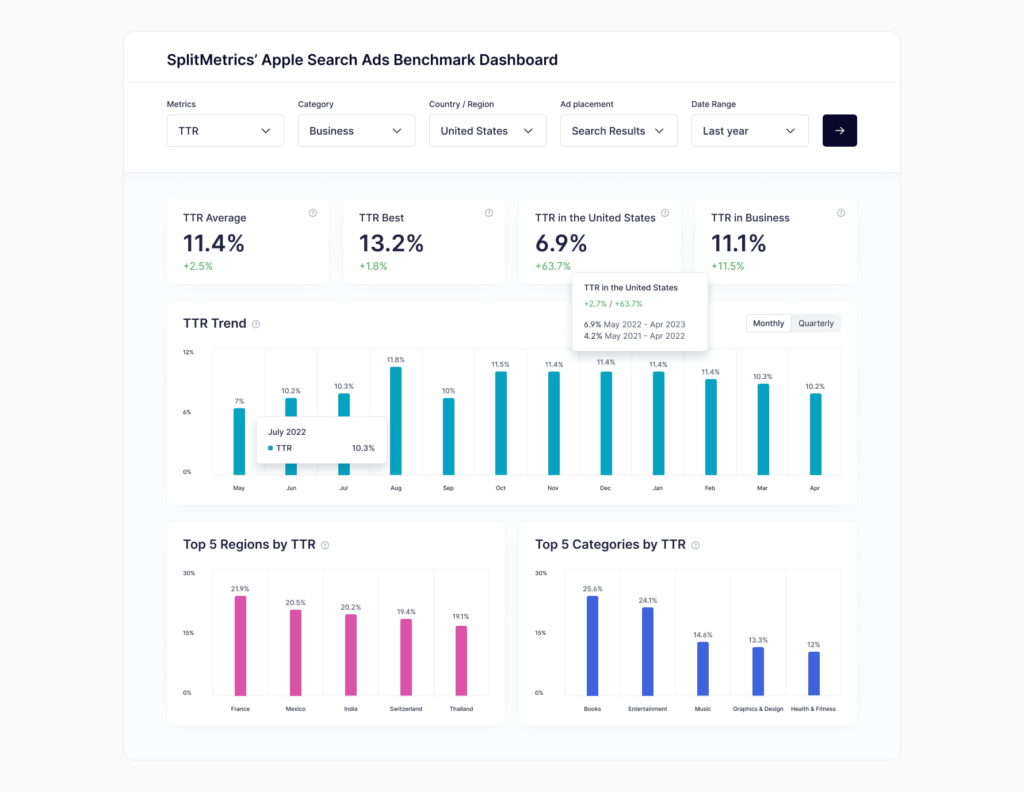
Newcomers also need to understand Apple Ads’ core value. The platform can connect with high-value users. Knowing what the reward may be should call for an adequate bidding strategy.
| LTV ($) | 0D | 1D | 7D | 14D | 30D | 45D | 60D |
| iOS | 0.3937 | 0.4447 | 0.6065 | 1.24 | 2.23 | 2.68 | 3.17 |
| Android | 0.0086 | 0.0093 | 0.0112 | 0.0129 | 0.0129 | 0.0142 | 0.0162 |
Apple Ads’ campaign structure for search results ads organizes keywords to reflect their themes or values. Both factors tremendously impact their goals and consequently, bidding strategy. Maintaining a transparent campaign structure is also essential to setting up efficient automation.
Successful bidding means adapting swiftly to the dynamic market changes occurring on the App Store. User engagement and consequently, ad performance, are subject to seasonality, new trends, or the dynamic expansion of new apps.
Ultimately, the most critical data is our own, related directly to our app. Approaching an entirely new campaign for a new app is very different from managing a mature campaign for a well-established app.
Regardless of any benchmark or reference points that Apple Ads or SplitMetrics Acquire can give, you must be ready to test and experiment with ad placements and keywords alike.
Users’ journey directly impacts how and when bids are adjusted. The path to a simple purchase is shorter than a long-term subscription, significantly impacting the analyzed timeframes, bid adjustment frequency, and their values. The bigger the commitment or expenditure, the longer the wait and the higher the spend.
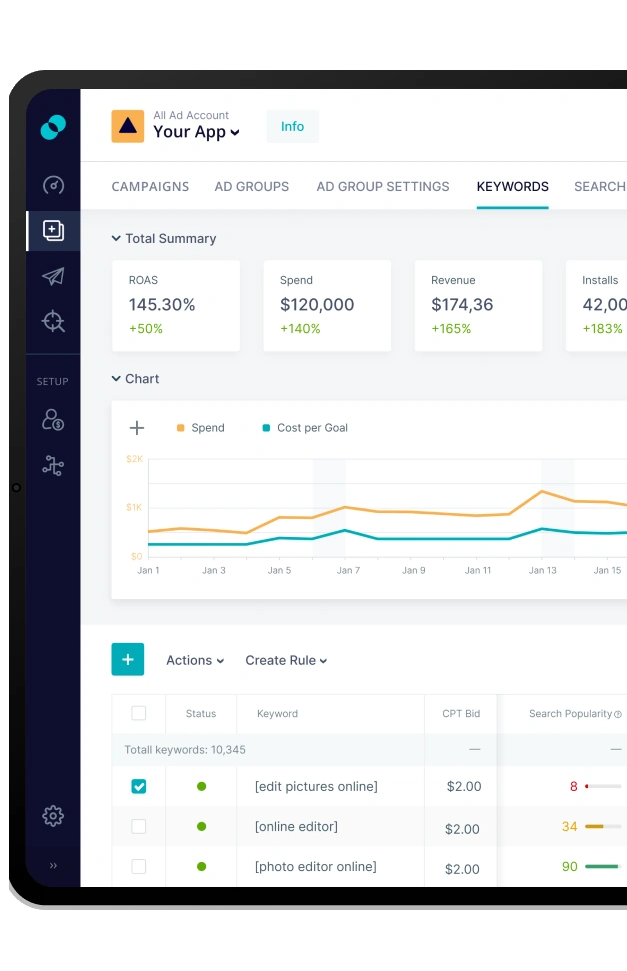
Having the preparations out of the way, let’s get to practice. In theory, bid optimization is straightforward and involves the following activities:
In practice, reaching profitability won’t be possible without considering an array of factors that determine our approach to bidding, which should be strategic and managed within a transparent and well-defined framework that will precisely define:
The bid optimization process should be strategic and focused on your target cost per acquisition (CPA), cost per goal (CPG), or return on ad spend (ROAS), with all factors mentioned above taken into consideration.
As hinted before, there’s a wide range of factors impacting a bidding strategy:
Let’s break down recommended approaches to bidding to various campaign types and scenarios.
Brand campaigns may (and with dedication, most likely will) contain your most valuable branded keywords, enjoying high tap-through and conversion rates and other performance metrics. A proactive, generous approach is recommended to maximize their profitability and take the full advantage of their potential, and to ensure proper brand protection.
Competitor campaigns can be a significant source of user acquisition. However, they require diligent monitoring to avoid overspending. This can happen when targeted competitors launch brand defense campaigns.
Category campaigns contain more general keywords that relate to your app’s category or functionality. Bidding on generic keywords requires a strategic balance between bid amount and ad relevance. Category campaigns can be very diverse in value and consequently may become more granular than other campaigns.
Our guide to building a semantics-based campaign structure describes creating diverse category campaigns, waterfalling their budgets, and managing bids for them.
Discovery campaigns require a cautious approach, as we need to efficiently test new search terms before adding them to other campaigns. Typically, a discovery campaign is assigned the remaining budget (with the exact percentage depending on overall campaign maturity), with bidding incrementally increased to a level allowing early evaluation.
New campaigns require testing and experimentation. Indicators provided by Apple Ads or benchmarks acquired through any other source can be invaluable. However, due to the dynamic nature of auctions, what can be considered a competitive bid changes fast.
You can quickly boost new keywords and ads to collect performance data. Still, it’s crucial to maintain systematic check-ups, pause those underperforming keywords, or increase your max CPT values for those with good results.
Existing campaigns allow a more nuanced approach. Analyze the performance of your keywords and bid history, and adjust your bids accordingly. Allocate higher bids to keywords that are driving conversions and lower bids to those that are less effective, following the principles described before.
Seasonality plays a vital role in shaping the value of the most important KPIs across all global markets. Make sure to factor them in your strategy. Set up automation rules and alerts to detect changes quickly. Source: SplitMetrics Apple Ads Search Results Benchmarks Report.
Bid increments and change frequency should be strategically planned based on the ongoing campaign performance and its relationship to our targets. Let’s examine the chart below:
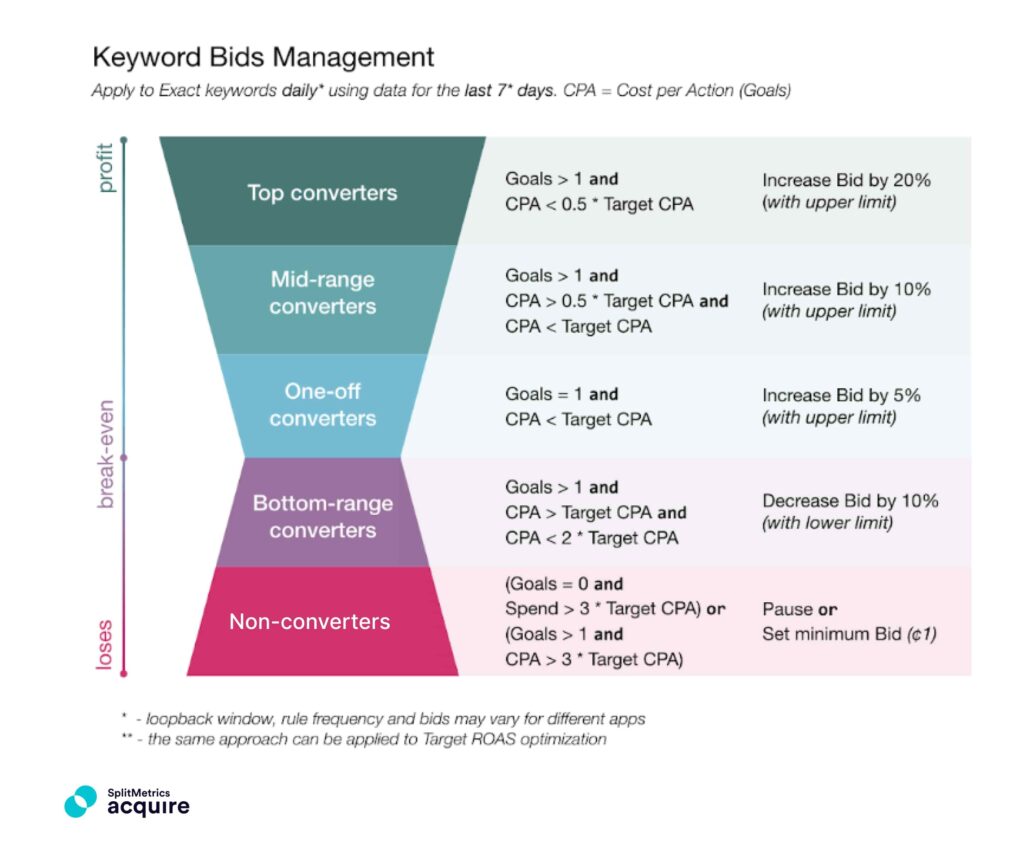
Keywords are classified according to their value, which is determined by the interrelationship between the actual cost per goal and the desired target. This is the key factor behind establishing bid increments, or how actively we bid on a given keyword. In essence:
These are the principles. Let’s discuss two popular strategies, taking them into account.
The Tunnel Strategy is a great way to approach CPA optimization through bidding. It revolves around gradually adjusting bids within a “tunnel” created by two metrics: maximum and minimum CPG/CPA. The chart below illustrates the concept:
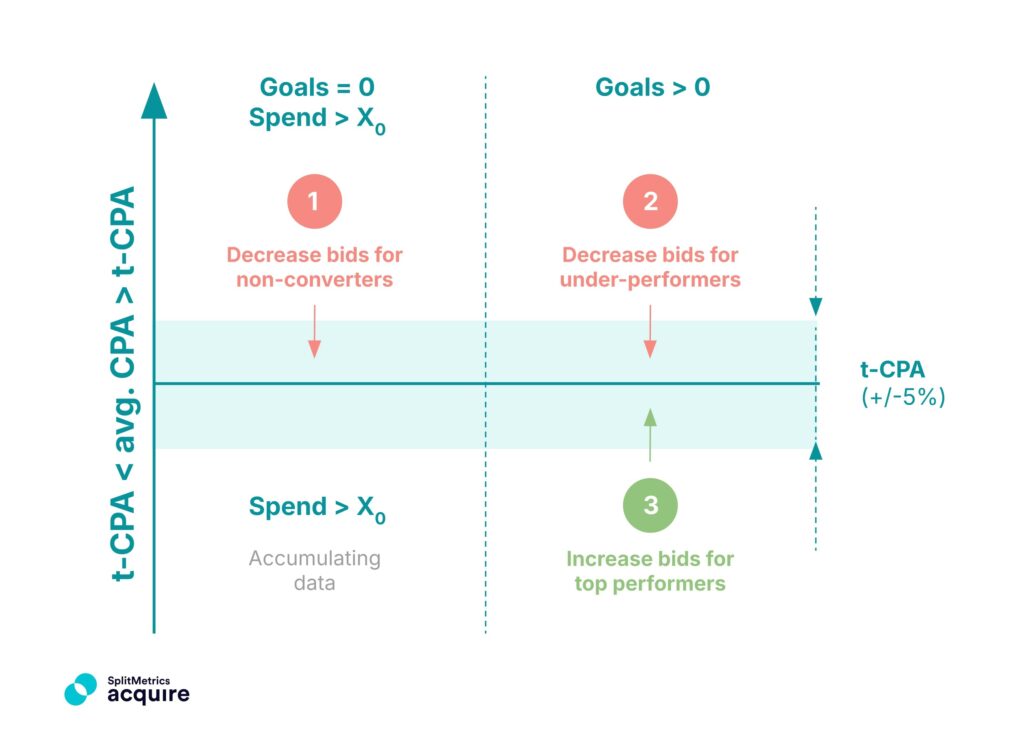
This strategy requires historical data for implementation, but by sticking to it, you will be able to get more downloads while reducing the cost per acquisition/goal.
This strategy assumes that limited performance can be detected early, as low tap-through or conversion rates signify a low probability of performing a revenue-generating action inside the app. As with the tunnel strategy, you need historical data to properly implement the Funnel Strategy and determine your target cost per goal (CPG) and optimum spend levels.

Implementing these strategies requires historical data and a solid framework to adjust bids strategically, with little to no room for decisions that aren’t purely data-driven. Given the scope, it’s easiest to implement them along with automation.
Another example of aligning bidding with a specific metric is maximizing impression share. It’s relevant for brand campaigns, which should have an impression share of around 90-95%. This ensures protection from competitors who might bid on your keywords and claim your precious traffic.
In other cases, fixating on a solid impression share doesn’t have to be productive, as the primary goal is to consistently deliver maximum goals or downloads at optimal CPA and CPG.
However, you may be interested in boosting impressions for new keywords to try out their potential as quickly as possible. This is especially important if you plan to focus on goals and CPG, as the conversion delay in such a case may be more significant.
Automation and artificial intelligence offer unmatched performance when it comes to bid optimization. Bid optimization is the most frequent and repetitive part of Apple Ads management, and it should ideally be strictly data-driven and swift in responding to changing market conditions.
Introducing simple automation rules to our campaigns fosters an environment where we organize our bidding in a transparent, strategic framework. This is a simple yet powerful reason why advertisers running Apple Ads through our platform will likely succeed and find profitability with this channel.

SplitMetrics AI takes Apple Ads bidding to a new level, making more, ever-improving adjustments to our campaigns, provided they have sufficient performance data.
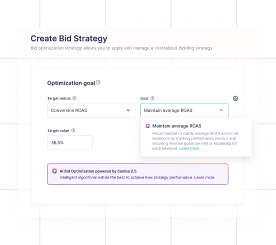
Here’s a collection of tips & best practices to wrap up.
Bidding in Apple Ads requires strategic thinking, data analysis, and continuous optimization. It benefits greatly from automation and will be elevated by machine learning and artificial intelligence, ready to support any advertiser, who’ll be free to focus on many more areas requiring their expertise: keyword research, creative optimization, or strategic app store optimization (ASO).
